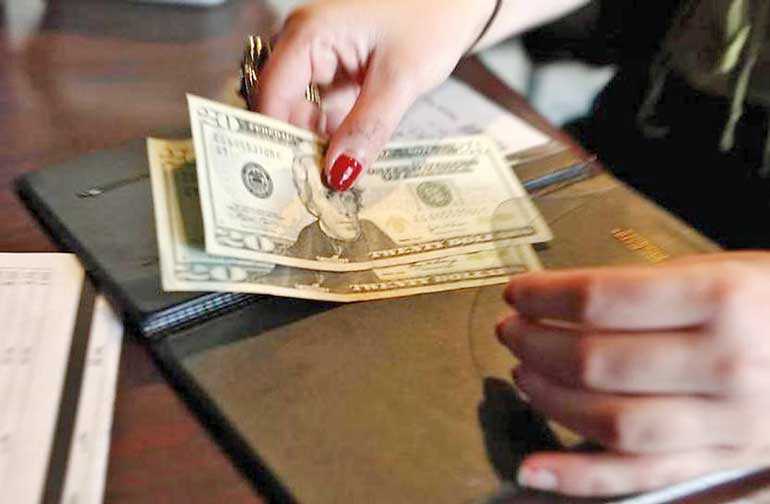Friday Mar 14, 2025
Friday Mar 14, 2025
Monday, 4 March 2019 00:00 - - {{hitsCtrl.values.hits}}

WASHINGTON (Reuters): US personal income fell for the first time in more than three years in January and consumer spending dropped by the most since 2009 in December, putting the economy on a weak growth path early in the first quarter.
The economic outlook was also darkened by other data on Friday showing factory activity hit a more than two-year low in February, with manufacturers reporting slowing new orders and hiring. The reports extended the run of soft data on an economy that lost momentum at the tail end of 2018 and gave more credence to the Federal Reserve’s “patient” stance towards raising interest rates further this year.
The economy is losing speed as the stimulus from a $ 1.5 trillion tax cut package and increased government spending fades. A trade war between the United States and China, higher interest rates, softening global growth and uncertainty over Britain’s exit from the European Union are clouding the outlook.
“A modest slowdown remains the most likely path for 2019,” said Eric Winograd, senior US economist at Alliance Bernstein in New York. “We shouldn’t expect any action from the Fed into at least the second half of the year.”
The Commerce Department said personal income slipped 0.1% in January, the first decline since November 2015, after jumping 1% in December. Income was weighed down by decreases in dividend, farm proprietors’ and interest income.
Income was boosted in December by a one-time special dividend by information technology firm VMware Inc as well as government payments to farmers caught up in the US-China trade war.
Wages increased by a moderate 0.3% in January after rising 0.5% in December. Economists polled by Reuters had forecast incomes rising 0.3% in January.
The Commerce Department did not publish the January consumer spending portion of the report as the collection and processing of retail sales data was delayed by a 35-day partial shutdown of the government that ended on 25 January.
It reported that consumer spending, which accounts for more than two-thirds of US economic activity, dropped 0.5% in December. That was the biggest decline since September 2009 and followed a 0.6% increase in November.
Households cut back on purchases of motor vehicles and recreational goods in December, leading to a 1.9% plunge in spending on goods. Spending on goods increased 1.0% in November. Outlays on services edged up 0.1%, held back by a decline in spending on household electricity and gas. Spending on services advanced 0.4% in November.
When adjusted for inflation, consumer spending fell 0.6% in December, also the largest drop since September 2009, after rising 0.5% in November. The December data was included in the fourth-quarter gross domestic product report published on Thursday, which showed consumer spending growing at a 2.8% annualised rate during that period, slower than the third quarter’s robust 3.5% pace. The economy grew at a 2.6% rate in the October-December quarter after notching a 3.4% pace in the third quarter.
The dollar was little changed against a basket of currencies. Stocks on Wall Street were trading higher, while US Treasury prices fell. The sharp deceleration in consumer spending in December puts consumption on a lower growth trajectory in the first quarter and bolsters analysts’ expectations that the economy will slow down further in the first three months of the year.
“Unless there is a big upward revision to the disastrous December retail sales figure, the weak end-of-quarter consumption profile provides for very challenging arithmetic for first-quarter consumption growth,” said Michael Feroli, an economist at JPMorgan in New York.
Still, consumer spending likely remains supported by a strong accumulation of savings, which surged to a six-year high of $ 1.2 trillion in December from $961.3 billion in November. The saving rate jumped to a three-year high of 7.6%. In addition, consumer sentiment remains high.
With spending tanking, inflation remained tame in December. The personal consumption expenditures (PCE) price index excluding the volatile food and energy components rose 0.2% after a similar gain in November.
That left the year-on-year increase in the so-called core PCE price index at 1.9%. The core PCE index is the Fed’s preferred inflation measure.
It hit the US Central Bank’s 2% inflation target in March for the first time since April 2012. Inflation is likely to remain benign despite a tight labour market as supply constraints at factories ease. A third report on Friday showed the Institute for Supply Management’s (ISM) national factory activity index fell 2.4 points to 54.2 last month, the lowest reading since November 2016. A reading above 50 in the ISM index indicates an expansion in manufacturing, which accounts for about 12% of the US economy.
Discover Kapruka, the leading online shopping platform in Sri Lanka, where you can conveniently send Gifts and Flowers to your loved ones for any event including Valentine ’s Day. Explore a wide range of popular Shopping Categories on Kapruka, including Toys, Groceries, Electronics, Birthday Cakes, Fruits, Chocolates, Flower Bouquets, Clothing, Watches, Lingerie, Gift Sets and Jewellery. Also if you’re interested in selling with Kapruka, Partner Central by Kapruka is the best solution to start with. Moreover, through Kapruka Global Shop, you can also enjoy the convenience of purchasing products from renowned platforms like Amazon and eBay and have them delivered to Sri Lanka.
Discover Kapruka, the leading online shopping platform in Sri Lanka, where you can conveniently send Gifts and Flowers to your loved ones for any event including Valentine ’s Day. Explore a wide range of popular Shopping Categories on Kapruka, including Toys, Groceries, Electronics, Birthday Cakes, Fruits, Chocolates, Flower Bouquets, Clothing, Watches, Lingerie, Gift Sets and Jewellery. Also if you’re interested in selling with Kapruka, Partner Central by Kapruka is the best solution to start with. Moreover, through Kapruka Global Shop, you can also enjoy the convenience of purchasing products from renowned platforms like Amazon and eBay and have them delivered to Sri Lanka.